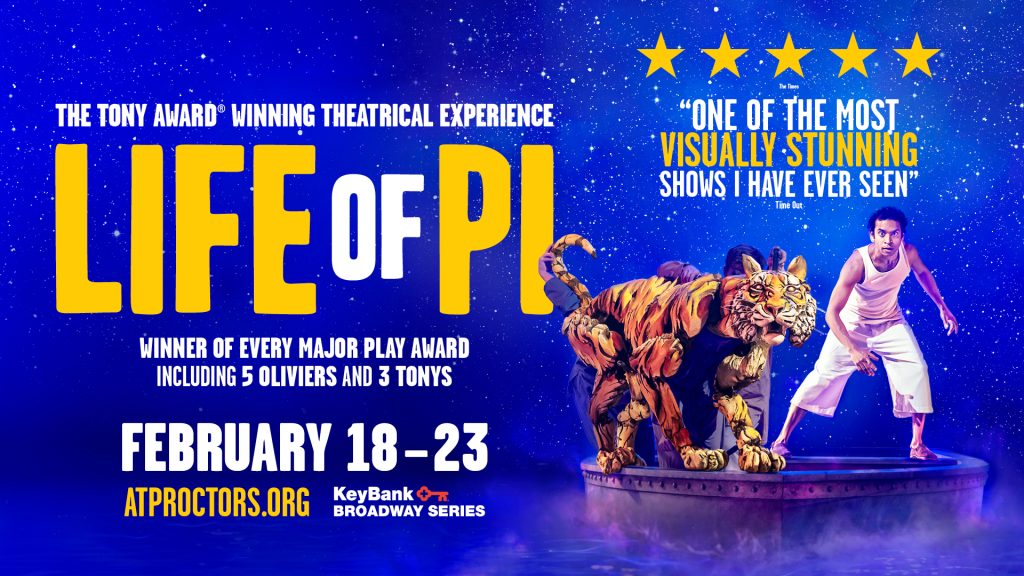“Life of Pi” brings animals to life on stage

Puppetry a star of Broadway play
SCHENECTADY— The modern classic “Life of Pi” finds a new revival with its national Broadway tour. The play is unlike anything you’ve seen, using imagery and puppetry to bring this innovative story to life. When you hear the word, “puppet,” images of children’s playthings might initially come to mind, but “Life of Pi” is a spectacular performance of artistry and imagery, and aimed for a mature audience.
It’s important to note the main characters of this story are largely animals and it mostly takes place on the open sea. The stage production, developed by Lolita Chakrabarti, has been praised for its stunning visual design, which includes visual effects, a highly imaginative set and incredible performers who bring characters like Richard Parker – the Bengal tiger, that shares a small lifeboat with Pi – to life.
When talking about the production, puppets is hardly the right word to use to describe these spectacular animals that stun throughout the play but nonetheless, puppets they are. It takes three trained professionals to breathe life into Parker. Ben Durocher, the head of the Bengal tiger is responsible for his ideas, sounds and emotions. Shiloh Goodin, Anna Leigh Gortner, Austin Wong Harper and Aaron Haskell work with Durocher to truly capsulate all the movements of the Bengal tiger.
According to Durocher, “It felt like I was learning puppetry for the first time again, because the style of puppetry in the show is very specific and it’s very athletic and physically demanding. … Then the other element is learning about the animals that we’re playing because the puppetry, for the most part, in the show is very naturalistic. We want the animals to seem as real as possible.”
Director of Puppetry Finn Caldwell is renowned for his work, and his innovative puppetry designs are a key component in “Life of Pi’s” success. The actors who perform for the puppets have a very physically demanding job. Playing different roles throughout the play – the puppeteers are the unseen stars of the show.
“The teamwork element is really special. Theatre is a team sport, and this show in particular asks the performers to really work as an ensemble to tell the story. Everyone is playing multiple roles, and we all as an ensemble, puppeteer objects. There’s a big shipwreck that happens and all the debris from the shipwreck gets thrown about, and we get to bring that to life as an ensemble! It is a lot about trusting the other performers and getting to work as a unit to bring this story to life,” Durocher explained.
Based on the novel by Yann Martel, the Broadway play “Life of Pi” is a fantastical survival story that blends adventure, spirituality and introspection. Following Pi Patel, a young Indian boy from Pondicherry, who survives a shipwreck in the Pacific Ocean, he is stranded on a lifeboat with a Bengal tiger named Richard Parker, a zebra, a hyena and an orangutan. As time passes, Pi must use his resourcefulness and faith to survive, all while sharing the lifeboat with the dangerous tiger.
“The story itself is all about resilience, faith and belief and storytelling. How we tell our story to the world and how we interpret other stories. There’s a lot in there that I think audiences can relate to and messages that are pertinent right now,” Durocher said.
“And then as a fan of puppetry, it’s exciting for a piece that uses puppetry in a way that isn’t just for young audiences. “Life of Pi” shows another side of this art form that is really dynamic and emotional and brutal at times, but it allows adult audiences to see puppetry in a way that maybe they hadn’t before,” he added.
Tickets are on sale now for this unforgettable play. Visit the Box Office at Proctors in-person or via phone at (518) 346-6204 Tuesday-Saturday 12 p.m.-6 p.m. or buy online by visiting atproctors.org.











